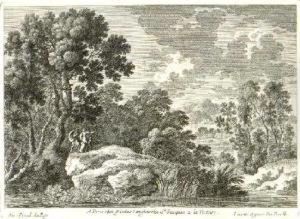Nicolas Perelle Paintings
Nicolas Perelle, born in 1631, was a French artist known primarily for his works as an engraver, draftsman, and printmaker. His reputation is largely founded on his detailed and picturesque engravings of landscapes and gardens, which offer insightful depictions of 17th-century France. Perelle specialized in topographical views and was particularly adept at capturing the grandeur of contemporary French gardens, such as those designed by André Le Nôtre for Louis XIV.
Nicolas came from a family of artists, with his father, Gabriel Perelle, also being an accomplished engraver. Under his father's tutelage, Nicolas, along with his brothers Adam and Gabriel II, learned the art of engraving and became involved in the family business. The Perelle family produced a vast number of prints that served as records of the changing French landscape during the reign of Louis XIV, including the changes wrought by the ongoing construction at Versailles and other royal châteaux.
Nicolas Perelle's works were not only artistic but also had practical implications. His engravings served as a form of documentation and propaganda, reflecting the power and taste of the French monarchy, and they were used to disseminate the grandeur of French cultural achievements across Europe. Perelle’s engravings were collected and bound into volumes, which became sought-after items among the European elite, who were fascinated by the splendor of French architecture and landscape design.
While Nicolas Perelle's works were largely overshadowed by the grand paintings and sculptures of the time, his contribution to the arts was significant in its own right. His engravings provided a visual record of an era that was defined by its grandiose expression of royal power and its development of formalized garden spaces. Nicolas Perelle died in 1695, leaving behind a body of work that continues to be appreciated for its historical value and its artistry.







